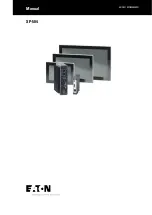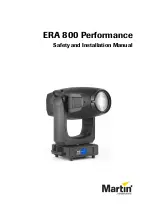
OPERATION
ENGLISH
23
Operation of the grooving machine
The thickness of the tube wall must not exceed the
aforementioned maximums.
With the cylinder valve closed, turning clockwise, press
the switch and run the machine idle to ensure that it
operates correctly.
Exert pressure downstream quickly on the pump handle
to make the initial groove. Continue, however slowly,
allowing that the tube makes one full turn for each
complete stroke of the pump handle.
If the tube starts to come out of the lathe screw,
stop the machine and check the
“tube
assembly”
procedures.
When the depth set nut makes contact with the
machine casing allow the tube to make two full turns
to level the depth of the groove.
Open the cylinder valve turning anticlockwise allowing
the upper roller to release the tube.
Check the diameter of the groove prior to proceeding
with the subsequent grooves.
The groove diameter must be measured using a
diameter tape. In order to reduce the groove diameter
(increase the depth of the groove), turn the depth
set nut one mark to the left. In order to increase the
groove diameter (decrease the depth of the groove),
turn the depth set nut for one mark to the right. Once
the set nut has been turned fix its position by fastening
the adjusting locknut.
When threading long tubes, use a stabiliser for the
tube to ensure that the tube does not vibrate due to
warping as it rotates, and to ensure that the machine
does not become unstable due to the weight of the
tube.
If you do not use a stabiliser for the tube it may prove
difficult to produce proper grooves, or the machine
may be damaged and result in accidents or injury.
Knurling with stabiliser
Do not use the stabiliser with tubes of 165 mm or less.
Your finger could be crushed by the rotating parts.
The stabilizer help to solve the problem of brusque
swinging during the knurling process due to roughness
and poor
grooving in large steel tubes (more than 165
mm).
Once the stabiliser has been adjusted for a specific
diameter and wall thickness it does not have to be
readjusted.
Position the tube in such a way that it is levelled and
makes contact with the lathe screw edge.
Exert downstream pressure on the pump handle to
move the upper roller until making contact with the
tube.
Turn the wheel to move the stabiliser roller downwards
until making contact with the outer diameter of the
tube. Once the stabiliser has made contact with the
outer diameter of the tube, tighten it with another
full turn and fix the slide locking screw to reduce the
vibration.
Summary of Contents for 162600
Page 29: ...95 1 2 OFF ON OFF 3 4...
Page 30: ...96 5 6 OFF 7 8 9 10 11 12 13 ON...
Page 31: ...97 14 15 16 17 18 19 20 21...
Page 32: ...98...
Page 34: ...100 55mm 3 4 A B...
Page 35: ...101 1 4 15 0 2 3 5 4 2 11mm 2 11mm 0 1mm...
Page 36: ...102 6 7 2 11 mm 8...
Page 37: ...103 165mm 165 mm...
Page 38: ...104 1 2 12 141 142 19mm 15 88mm...
Page 40: ...106 1 165 mm...
Page 41: ...107 0...
Page 42: ...108 10 20 10...
Page 43: ...SPARE PARTS 135 CORPS DE LA MACHINE BODY OF THE MACHINE...
Page 45: ...SPARE PARTS 137 VERIN HYDRAULIQUE HYDRAULIC CYLINDER...
















































